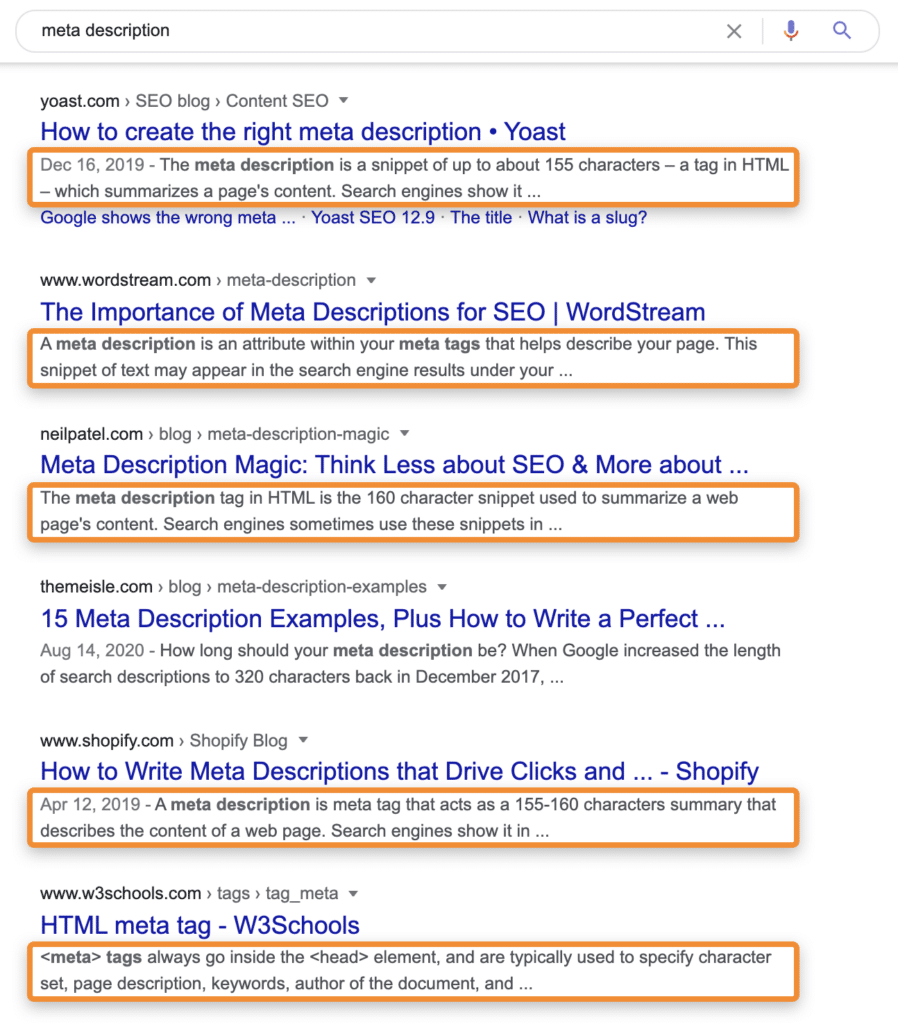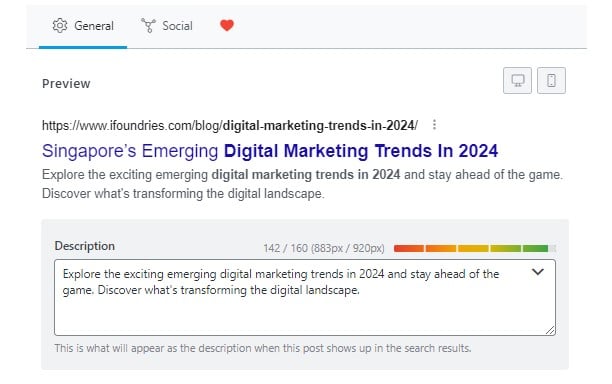When you enter a search term on Google and are presented with results, do you notice the short summaries below the title and usually beside the publishing date?

(Ahrefs)
These are called meta descriptions, and they inform and interest users by providing a relevant snippet of the page’s content.
Meta descriptions play a pivotal role in capturing the attention of users and search engines alike. Now, more than ever, the battle for online visibility and user engagement is more intense. So, to gain a competitive edge, businesses and digital marketing agencies must master the art of meta descriptions.
This article explores meta description best practices that can elevate a brand’s online presence.
By understanding the significance of meta descriptions in SEO services and digital marketing strategies, agencies can unlock the potential for higher visibility and increased success in the ever-evolving digital landscape.
What is Meta Description?
A meta description is a snippet of HTML code that summarises a web page’s content and quality. It is a condensed preview of a page’s content, which appears beneath its link and title on Google search engine results pages (SERPs). These concise snippets of text hold the power to significantly impact search engine rankings, click-through rates, and overall user engagement.
Google can use your description or rewrite it based on your webpage and the user’s search query. So, it is crucial to write meta descriptions that are unique and highly relevant to the page.
Moreover, most Content Management Systems (CMSs) provide the flexibility to add meta descriptions by either modifying or inserting them using coding in your page or utilising the meta description field in the page’s metadata settings, often facilitated by plugins like RankMath.
Here’s an example of using RankMath in WordPress for meta description writing:

Why is Meta Description Important?
Meta descriptions are vital because they are significant in search engine result pages (SERPs), Click-Through Rates (CTR) and user engagement.
Search engines use meta descriptions to assess a web page’s relevance to a specific search query. When crawling and indexing websites, search engine algorithms analyse meta descriptions to understand what each page is about.
By optimising meta descriptions with relevant keywords, businesses and digital marketers can signal to search engines that their content is directly related to popular search queries, thereby increasing the chances of higher rankings in SERPs.
Additionally, a well-crafted meta description that resonates with the user’s search intent and showcases the value of the content entices them to click on the link and explore further. While, a poorly written or irrelevant meta description may discourage users from clicking on the link, leading to missed opportunities for engagement and conversions.
Understanding the significance of meta descriptions is vital for businesses and a digital marketing agency looking to elevate their online presence. By crafting compelling and relevant descriptions through meta description best practices, websites can increase their chances of appearing in top search results, driving higher click-through rates and ultimately engaging more users.
How to Write and What are Meta Description Best Practices
1. Include your main or target keyword
One key principle in learning how to write a meta description is to include your target keyword or the primary search query you want your page to rank for in your description.
Google adds a bold markup to the words that are synonymous or related to the query, encouraging users to click. See the example below for the keyword “ai cms Singapore”:



2. Optimise your meta description length
To tell you the truth, there is technically no exact meta description character limit, but it is important to know that Google automatically shortens descriptions based on the available space.
Be aware that truncated meta descriptions can negatively affect your CTR. Displayed snippets may also depend on the web visitor’s search query, device, and character width.
So, how long should the meta description be? The common meta description length is 50 to 160 characters long. On desktops, Google typically truncates meta descriptions to around 152 characters. For mobile devices, the character limit is even shorter, at around 105 characters.
There may be other estimations, but 155 characters is the usual recommendation.
3. Incorporate a call-to-action (CTA)
Another one of the meta description best practices is ensuring that you attract your readers or searchers by calling them to take action according to your content’s purpose. For example, you’ve recently published an informative blog or eGuide about artificial intelligence in CMS. Include the following words in your meta description to engage and persuade your audience:
- Discover
- Learn more
- Read on,
- Find out
- Explore, etc.
You can use these verbs at the start of your sentences, paired with a more straightforward and concise writing style to captivate your audience better. Mention what’s in it for them and what they can expect in your webpage content.
4. Leverage question-based queries and provide direct answers
Focusing on question-based queries is also one of the meta description best practices you should note. When users pose specific questions in their search queries, search engines aim to provide them with direct answers. Structure your meta description to address the question directly.
Start the meta description with the question itself and follow it with a concise, well-crafted answer. The goal is to offer a clear and comprehensive response that satisfies the user’s query. Use natural language and avoid keyword stuffing, as search engines prioritise content that genuinely provides value to users.
For example, if your target keyword is “best places to visit in Singapore,” create a meta description that starts with “Discover the top 10 best places to visit in Singapore” and continues with a list of the attractions.
5. Use Schema Markup to enhance meta description visibility
Schema markup, also known as structured data, is a powerful feature that enables search engines to better understand the content and context of web pages. By incorporating schema markup into your website’s code, you can provide additional context to search engines about the content you offer, making it more likely to be considered for featured snippets. Featured snippets are a highly coveted spot in search engine result pages (SERPs) that can significantly enhance a website’s visibility and credibility. These succinct, highlighted summaries are often displayed at the top of search results, providing direct answers to user queries.
More so, one specific type of schema markup that can benefit meta descriptions is the “FAQ schema.” Implementing this schema on pages with question-based content allows search engines to identify the questions and answers explicitly.
Furthermore, depending on the nature of your content, consider using other relevant schema types, such as “HowTo” or “FAQPage.” These markup types provide a structured format for presenting information, which search engines find valuable when selecting content for featured snippets.
6. Harness the power of meta tags
Meta tags are HTML tags that provide extra information about a page to search engines and other clients. They are added to the head section of an HTML page and are only visible in the HTML code. Although they don’t directly affect search rankings, they are essential for optimising user experience and driving engagement.
a. The Meta Description Tag: The meta tag description (also known as the meta tag “description” attribute) is crucial for search engines to understand the content of your page accurately. It serves as the default meta description when one is not explicitly provided. Ensure it is compelling, concise, and reflects the page’s main content.
b. Other Relevant Meta Tags: In addition to the meta description, utilise other relevant meta tags, such as the title tag, meta keywords, and meta robots tags, to enhance your SEO efforts further. While most search engines no longer consider the meta keywords tag, the others play essential roles in improving search engine visibility and user experience.
By applying meta description best practices, your web page can soar in visibility and engagement
Optimise your meta descriptions’ word length and content. Take advantage of question-based queries, schema markup, and meta tags—these meta description best practices allow your content to be more visible in search engine results pages while increasing the chances of users clicking through to your website.
While it is true that Google sometimes rewrites descriptions despite your hard efforts to follow meta description best practices, you’ll need to focus on creating compelling and informative meta descriptions that satisfy Google’s algorithms and entice users to click.
An SEO agency will tell you that a well-crafted meta description can be the gateway to greater success for your brand, and we’re here to help you kickstart your SEO journey the right way.
Embrace the power of meta descriptions and unlock the potential to attract more organic traffic, boost user engagement, and outshine your competitors in the dynamic world of online marketing.






